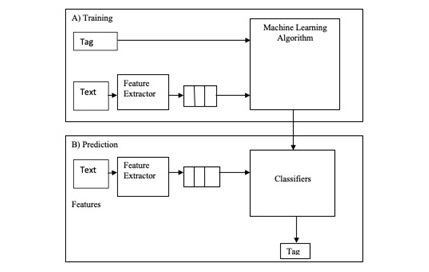A Comprehensive Analysis of Approaches for Sentiment Analysis Using Twitter Data on COVID-19 Vaccines

DOI:
https://doi.org/10.54060/JIEEE/002.02.009Keywords:
Sentiment Analysis, Machine Learning, Supervised Learning, , Unsupervised learning, TwitterAbstract
Sentiment Analysis has paved routes for opinion analysis of masses over unrestricted territorial limits. With the advent and growth of social media like Twitter, Facebook, WhatsApp, Snapchat in today’s world, stakeholders and the public often takes to ex-pressing their opinion on them and drawing conclusions. While these social media data are extremely informative and well connected, the major challenge lies in incorporating efficient Text Classification strategies which not only overcomes the unstructured and humongous nature of data but also generates correct polarity of opinions (i.e. positive, negative, and neutral) . This paper is a thorough effort to provide a brief study about various approaches to SA including Machine Learning, Lexicon Based, and Automatic Approaches. The paper also highlights the comparison of positive, negative, and neu-tral tweets of the Sputnik V, Moderna, and Covaxin vaccines used for preventive and emergency use of COVID-19 disease.
Downloads
References
S. Kaur, P. Kaul, and P. M. Zadeh, “Monitoring the dynamics of emotions during COVID-19 using twitter data,” Procedia Comput. Sci., vol. 177, pp. 423–430, 2020.
R. A. King, P. Racherla, and V. D. Bush, “What we know and don’t know about online word-of-mouth: A review and synthesis of the literature,” J. Interact. Mark., vol. 28, no. 3, pp. 167–183, 2014.
M. Kanakaraj and R. M. R. Guddeti, “Performance analysis of Ensemble methods on Twitter sentiment analysis using NLP techniques,” in Proceedings of the IEEE 9th International Conference on Semantic Computing, March 2015
S. Shahheidari, H. Dong, and M. N. R. B. Daud, “Twitter Sentiment Mining: A Multi Domain Analysis,” in Seventh International Conference on Complex, Intelligent, and Software Intensive Systems, pp.144-149, July 2013.
M. S. Neethu and R. Rajasree, “Sentiment analysis in twitter using machine learning techniques,” in Fourth International Conference on Computing, Communications and Networking Technologies (ICCCNT), pp. 1-5, July 2013.
J. Jotheeswaran and S. Kodeeswaran, “Decision Tree Based Feature Selection and Multilayer Perceptron for Sentiment Analysis., “Journal of Engineering and Applied Sciences, vol. 10, no. 14, pp. 5883-5894, Jan 2015.
R. Jose and V. S. Chooralil, “Prediction of election result by enhanced sentiment analysis on Twitter data using Word Sense Disambiguation,” in International Conference on Control Communication & Computing India (ICCC), Nov 2015.
M. S. Wajid, S. Maurya, & R. Vaishya, “Sentence Similarity based Text Summarization using Clusters, “International Journal of Scientific & Engineering Research, vol.4, no. 5, pp.1959-1966, May 2013.
R. Jose and V. S. Chooralil, “Prediction of election result by enhanced sentiment analysis on twitter data using classifier ensemble Approach,” in International Conference on Data Mining and Advanced Computing (SAPIENCE), 2016.
S. Rajalakshmi, S. Asha, and N. Pazhaniraja, “A comprehensive survey on sentiment analysis,” in Fourth International Conference on Signal Processing, Communication and Networking (ICSCN), 2017.
J. Vijayaraj, R. Saravanan, P. Victer Paul, et al, “A comprehensive survey on big data analytics tools,” in Online International Conference on Green Engineering and Technologies (IC-GET), vol.2, pp.32-40,2016.
A. C. Pandey, S.R Seth, et al., “Sarcasm Detection of Amazon Alexa Sample Set, “Springer Nature Pte Ltd. Advances in Signal Processing and Communications, 2019.
D. U. R. Babu, “Sentiment analysis of reviews for E-shopping websites,” Int. j. eng. comput. sci., vol.6, no.1, pp.19965-19968, 2017.
M. Khurana, A. Gulati, and S. Singh, “Sentiment analysis framework of twitter data using classification,” in Fifth International Conference on Parallel, Distributed and Grid Computing (PDGC), Dec 2018.
N. Majumder, S. Poria, H. Peng, et al., “Sentiment and sarcasm classification with multitask learning,” IEEE Intell. Syst., vol. 34, no. 3, pp. 38–43, 2019.
S. Rajalakshmi, S. Asha, and N. Pazhaniraja, “A comprehensive survey on sentiment analysis,” in 2017 Fourth International Conference on Signal Processing, Communication and Networking (ICSCN), 2017.
F. H. Khan, S. Bashir, and U. Qamar, “TOM: Twitter opinion mining framework using hybrid classification scheme,” Decis. Support Syst., vol. 57, pp. 245–257, 2014.
S. Porwal, G. Ostwal, A. Phadtare, et al., “Sarcasm detection using recurrent neural network,” in Second International Conference on Intelligent Computing and Control Systems (ICICCS), pp. 746-748, 2018.
M. Bouazizi and T. Ohtsuki, “A pattern-based approach for sarcasm detection on twitter,” IEEE Access, vol. 4, pp. 5477–5488, 2016.
L. Nemes and A. Kiss, “Social media sentiment analysis based on COVID-19,” J. Inf. Telecommun., vol. 5, no. 1, pp. 1–15, 2021.
N. Mamgain, E. Mehta, A. Mittal, et al., “Sentiment analysis of top colleges in India using Twitter data,” in International Conference on Computational Techniques in Information and Communication Technologies (ICCTICT), pp. 525-530,2016.
P. Nambisan, Z. Luo, A. Kapoor, et al. “Social media, big data, and public health informatics: Ruminating behavior of depression revealed through twitter,” in 48th Hawaii International Conference on System Sciences, pp. 2906-291, 2015.
T. Tran and K. Lee, “Understanding citizen reactions and Ebola-related information propagation on social media,” in IEEE/ACM International Conference on Advances in Social Networks Analysis and Mining (ASONAM), pp. 106–111, 2016.
P. Song and T. Karako, “COVID-19: Real-time dissemination of scientific information to fight a public health emergency of international concern,” Biosci. Trends, vol. 14, no. 1, pp. 1–2, Mar 2020.
S. Kumar, A. K. Singh, P. Singh, et al, “Sentiment analysis based on A.i. over big data,” in Proceedings of the International Conference on Data Engineering and Communication Technology, Singapore: Springer Singapore, pp. 641–649, 2017.
K. Chakraborty, S. Bhatia, S. Bhattacharyya, et al., “Sentiment Analysis of COVID-19 tweets by Deep Learning Classifiers—A study to show how popularity is affecting accuracy in social media,” Appl. Soft Comput., vol. 97, p. 106-754, 2020.
M. M. Truşcă, “Efficiency of SVM classifier with Word2Vec and Doc2Vec models,” Proceedings of the International Conference on Applied Statistics, vol. 1, no. 1, pp. 496–503, 2019.
M. Bilgin and I. F. Senturk, “Sentiment analysis on Twitter data with semi-supervised Doc2Vec,” in International Conference on Computer Science and Engineering (UBMK), pp. 661–666, 2017.
K. Chakraborty, S. Bhattacharyya, R. Bag, et al., “Sentiment analysis on a set of movie reviews using deep learning techniques,” in Social Network Analytics, Elsevier, pp. 127–147, 2019.
S. Latif, M. Usman, S. Manzoor, “Leveraging data science to combat COVID-19: A comprehensive review,” IEEE Trans. Artif. Intell., vol. 1, no. 1, pp. 85–103, 2020.
S. Doğan, A. Betin-Can, and V. Garousi, “Web application testing: A systematic literature review,” J. Syst. Softw., vol. 91, pp. 174–201, 2014.
V.R. Madaan, K.K. Bhatia, S. Bhatia, “Understanding the role of emotional intelligence in usage of social media,” in10th International Conference on Cloud Computing, Data Science & Engineering (Confluence), pp. 586–591, Jan 2020.
B. A., Ninan, Sooraj, S. R. Ananthakrishnan et al., “Literature Review Web Application Designed for Schools and Colleges, “Imperial Journal of Interdisciplinary Research (IJIR), vol.2, no.4, pp.350-356, 2016.
D. Ciresan, U. Meier, and J. Schmidhuber, “Multi-column deep neural networks for image classification,” in IEEE Conference on Computer Vision and Pattern Recognition, pp. 3642-3649, 2012.
H. A. Shiddieqy, F. I. Hariadi, and T. Adiono, “Implementation of deep-learning based image classification on single board computer,” in International Symposium on Electronics and Smart Devices (ISESD), pp. 133-137, Oct 2017.
T. Molla, B. Khan, & P. Singh, “A comprehensive analysis of smart home energy management system optimization techniques, “Journal of Autonomous Intelligence, vol.1, no.1, pp.15-21, 2018.
P. Singhal, P. Singh and A. Vidyarthi, “Interpretation and localization of Thorax diseases using DCNN in Chest X-Ray, “Journal of Informatics Electrical and Electronics Engineering, vol.1, no. 1, pp.1-7, 2020.
M. Vinny, P. Singh, “Review on the Artificial Brain Technology: BlueBrain, “Journal of Informatics Electrical and Electronics Engineering, vol.1, no.1, pp.1-11, 2020.
A. Sahani, P. Singh and A. Kumar, “Introduction to Blockchain, “Journal of Informatics Electrical and Electronics Engineering, vol.1, no.1, pp. 1-9, 2020.
M. Misra, P. Singh, “Energy Optimization for Smart Housing Systems, “Journal of Informatics Electrical and Electronics Engineering, vol.1, no.1, pp. 1-6, 2020.
K. Chane, F.M. Gebru, B. Khan, “Short Term Load Forecasting of Distribution Feeder Using Artificial Neural Network Technique, “ Journal of Informatics Electrical and Electronics Engineering, vol.2, no.1,pp. 1-22, 2021.



























